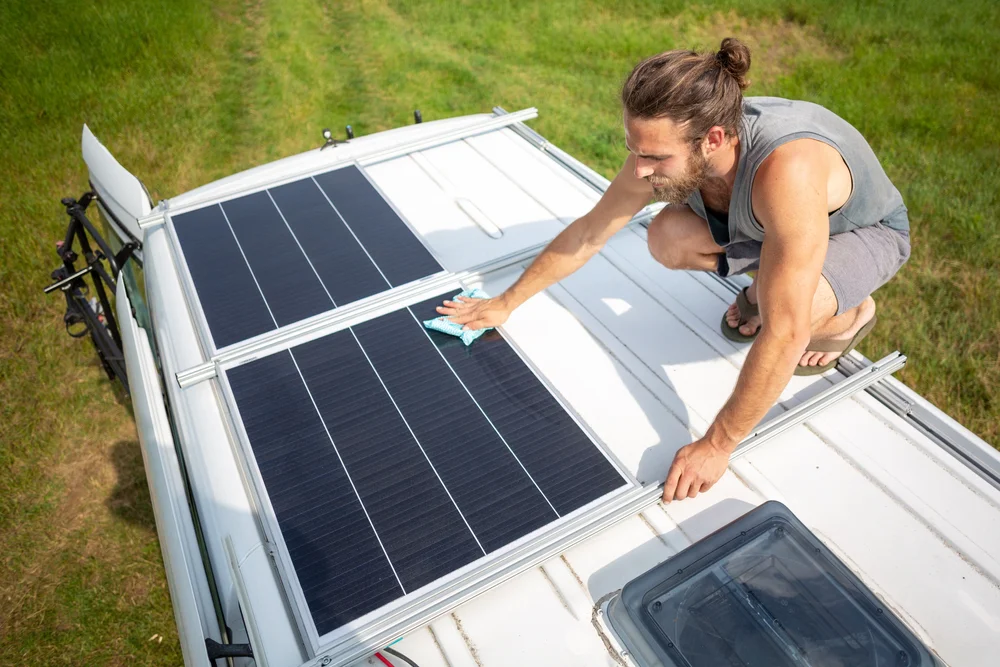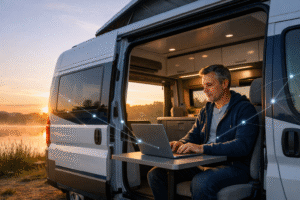Solar Power Solutions for Van Life: Harnessing Renewable Energy on the Go

Solar power solutions for van life are gaining popularity as more people embrace green travel and seek renewable energy options for their vehicles. Living on the road doesn’t mean sacrificing sustainability and eco-friendliness. With solar panels installed on campers, vans, and trailers, travelers can enjoy a sustainable and off-grid lifestyle.
Campervan electrics, including solar panels, batteries, inverters, charge controllers, fuses, and wiring, play a crucial role in harnessing solar power. These components provide campervan owners with a cost-effective and independent source of energy, ensuring that they can travel off-grid without relying on traditional power sources.
When it comes to solar panels, there are different types to choose from, such as monocrystalline, polycrystalline, and thin-film panels. Selecting the right location for installation, securely mounting the panels, and connecting them to a charge controller and battery are essential steps in the installation process.
Maintaining solar panels, batteries, inverters, and other components is crucial for their longevity and efficiency. Troubleshooting electrical issues may require checking connections, fuses, and using a multimeter. Seeking professional help is advisable when needed.
Solar power systems offer van lifers the flexibility and sustainability they desire. Alongside solar power, other options like generators and shore power can provide additional power sources. When choosing solar panels, it’s important to consider the differences between monocrystalline and polycrystalline panels. Inverters are necessary for converting DC power from batteries to usable AC power for appliances. AGM batteries are durable and less expensive, but their capacity is limited, while lithium batteries are more efficient but come with a higher price tag.
Proper wiring, installation, and the use of charge controllers are crucial for safety and efficiency. Automatic charging relays can even charge house batteries while driving, ensuring a continuous supply of power.
In conclusion, solar power solutions for van life offer a sustainable and eco-friendly way to harness renewable energy on the go. With the right components, proper installation, and maintenance, van lifers can enjoy off-grid travel while reducing their carbon footprint. Whether it’s charging electronics or running appliances, solar power provides the flexibility and independence desired by those living on the road.
- Solar panels are increasingly popular for campers, vans, and trailers, providing a sustainable and eco-friendly source of power for off-grid travel.
- Campervan electrics include solar panels, batteries, inverters, charge controllers, and wiring, all of which are essential for a self-sufficient power system.
- Different types of solar panels are available, including monocrystalline, polycrystalline, and thin-film panels, each with its own advantages and considerations.
- Proper maintenance and troubleshooting of solar panels, batteries, inverters, and other components are crucial for longevity and efficiency.
- Solar power systems in vans offer flexibility, sustainability, and the ability to charge electronics and run appliances on the go.
The Rise of Solar Panels for Van Life
Green Travel and the Need for Renewable Energy Solutions
As the popularity of green travel continues to rise, more and more people are turning to solar panels as a renewable energy solution for their campers, vans, and trailers. Living life on the road doesn’t mean sacrificing sustainability. Solar panels offer a sustainable and eco-friendly source of power, allowing for off-grid travel and reducing reliance on traditional energy sources.
Campervan electrics consist of various components, including solar panels, batteries, inverters, charge controllers, fuses and breakers, and wiring. Solar panels play a crucial role in powering campervans as they are not only sustainable but also cost-effective. By harnessing the power of the sun, van lifers can enjoy independence from the grid and reduce their carbon footprint.
There are different types of solar panels available, including monocrystalline, polycrystalline, and thin-film panels. Choosing the right type depends on factors such as efficiency, space limitations, and budget. Installing solar panels on a campervan involves careful consideration of the location, secure mounting, and proper connection to a charge controller and battery.
Harnessing Renewable Energy on the Go
Batteries are essential for storing the energy generated by solar panels. There are different types of batteries to choose from, including lead-acid, AGM, and lithium-ion batteries. Each type has its advantages and considerations. AGM batteries are durable and less expensive but can only utilize 50% of their total capacity. On the other hand, lithium batteries are more efficient, allowing for 80% of their total capacity to be used, but come at a higher cost.
To convert the DC power stored in the batteries into usable AC power for household appliances, inverters are necessary. Two main types of inverters are available: modified sine wave and pure sine wave inverters. The choice depends on the specific needs and requirements of the van lifer.
Charge controllers play a crucial role in regulating the power from solar panels and preventing overcharging. Two types of charge controllers are available: PWM (Pulse Width Modulation) and MPPT (Maximum Power Point Tracking). The selection of the appropriate charge controller depends on factors such as panel voltage and battery bank size.
Proper maintenance of solar panels, batteries, inverters, and other components is essential for longevity and efficiency. Regular inspections, cleaning, and monitoring can help identify and address potential issues before they become major problems. In case of electrical issues, it is important to check connections, fuses, and use a multimeter for troubleshooting. Seeking professional help may be necessary for complex problems.
Solar power systems in vans offer the flexibility and sustainability that van lifers seek. They provide the ability to charge electronics and run appliances on the go without relying on external power sources. While solar power is a popular option, other alternatives such as generators and shore power can also be considered depending on individual needs and circumstances.
When choosing solar panels, it is important to consider the differences between monocrystalline and polycrystalline panels. Each type has its own advantages and disadvantages, and the decision should be based on factors such as efficiency, space availability, and budget.
In conclusion, solar panels are revolutionizing the way van lifers power their vehicles. They offer a sustainable and cost-effective solution for off-grid travel, providing independence from the grid and reducing environmental impact. With proper installation, maintenance, and the right choice of components, van lifers can enjoy the benefits of harnessing renewable energy on the go.
*[AGM]: Absorbent Glass Mat *[PWM]: Pulse Width Modulation *[MPPT]: Maximum Power Point Tracking
like you who are constantly on the move. One of the biggest challenges for van life is finding a reliable source of power for your electrical needs. That’s where solar power solutions come in. By harnessing renewable energy from the sun, you can power your campervan and enjoy the freedom of off-grid travel.
Solar Panels
Solar panels are an essential component of campervan electrics. They are sustainable, cost-effective, and provide independence from the grid. There are different types of solar panels available, including monocrystalline, polycrystalline, and thin-film panels. Choosing the right type depends on your specific needs and budget.
Batteries
Batteries store the energy generated by solar panels, ensuring you have power even when the sun isn’t shining. Lead-acid, AGM, and lithium-ion batteries are commonly used in campervans. Each type has its pros and cons, with lithium-ion batteries being more efficient but also more expensive.
Inverters
Inverters convert the DC power stored in the batteries into AC power for your household appliances. There are two main types: modified sine wave and pure sine wave inverters. The type you choose will depend on the devices you plan to power.
Charge Controllers
Charge controllers regulate the power from the solar panels and prevent overcharging of the batteries. PWM (Pulse Width Modulation) and MPPT (Maximum Power Point Tracking) controllers are the two types available. MPPT controllers are more efficient but also more expensive.
Fuses and Breakers
Fuses and breakers are important safety features in any electrical system. They protect your equipment from damage caused by overloads or short circuits. It’s crucial to have the correct size and type of fuses and breakers installed.
Wiring
Proper wiring and installation are crucial for safety and efficiency. It’s important to use the right gauge wire for each component and ensure all connections are secure. Regular maintenance and inspections are necessary to identify any issues and prevent electrical problems.
In conclusion, campervan electrics consist of various components that work together to harness solar power for your van life adventures. Solar panels, batteries, inverters, charge controllers, fuses and breakers, and wiring all play a vital role in providing sustainable and reliable power on the go. By utilizing solar power solutions, van lifers can enjoy the flexibility and independence of off-grid travel while reducing their carbon footprint.
To learn more about harnessing solar power for RVs and van life, check out this resource for a deeper dive into the topic.
Benefits of Solar Panels on a Campervan
Sustainability
As the popularity of green travel continues to rise, more and more people living on the road are seeking renewable energy solutions for their vehicles. Solar panels have become a popular choice for campers, vans, and trailers, providing a sustainable and eco-friendly source of power. By harnessing the sun’s energy, campervan owners can enjoy off-grid travel while minimizing their carbon footprint.
Cost-effectiveness
Solar panels offer a cost-effective solution for powering a campervan. Once the initial investment is made, the energy generated by the panels is essentially free. This eliminates the need to rely on expensive fuel sources or campground hookups for electricity. With proper maintenance, solar panels can provide a reliable and long-lasting power solution, saving vanlifers money in the long run.
Independence from the Grid
One of the key advantages of solar panels on a campervan is the independence they provide from the electrical grid. Vanlifers can travel to remote locations and still have access to power for charging electronics and running appliances. Whether it’s working remotely, cooking meals, or powering entertainment devices, solar power systems in vans offer flexibility and sustainability.
By utilizing solar power solutions for van life, travelers can create a self-sufficient and eco-friendly lifestyle on the road. Solar panels, batteries, inverters, charge controllers, and proper wiring are essential components for a successful solar power system in a campervan. With the right setup and maintenance, vanlifers can enjoy the benefits of renewable energy while exploring the world around them.
For more information on solar power systems for van life, check out this research citation.
like me who are constantly on the move. One of the biggest challenges for van life enthusiasts is finding a reliable and sustainable power source. That’s where solar panels come in. Solar power solutions for van life offer a convenient and eco-friendly way to harness renewable energy on the go.
When it comes to solar panels, there are several types to choose from. Let’s explore three popular options:
Monocrystalline Panels
Monocrystalline panels are known for their high efficiency and sleek black appearance. They are made from a single crystal structure, which allows them to convert sunlight into electricity more efficiently than other panel types. Monocrystalline panels are a great choice for van lifers who have limited roof space but still want to maximize their power output.
Polycrystalline Panels
Polycrystalline panels, also known as multicrystalline panels, are made from multiple silicon crystals. They are less expensive to produce than monocrystalline panels, making them a popular choice among van lifers on a budget. While they may not be as efficient as monocrystalline panels, they still provide a reliable source of power for your van life adventures.
Thin-film Panels
Thin-film panels are the lightest and most flexible option on the market. They are made by depositing a thin layer of photovoltaic material onto a substrate. Thin-film panels are ideal for van lifers who want a lightweight and portable solar solution. However, they tend to have lower efficiency compared to crystalline panels.
When choosing the right solar panel for your van, consider factors such as efficiency, cost, and available space. Additionally, it’s important to consult with a professional to ensure proper installation and wiring for optimal performance and safety.
Remember, solar power solutions for van life offer a sustainable and cost-effective way to power your adventures on the road. With the right solar panel setup, you can enjoy the freedom of off-grid travel while reducing your carbon footprint.
For more information on harnessing solar power for van life, check out this resource by Bowerbird Energy.
like you, who are constantly on the move. We understand the importance of harnessing renewable energy for your van life adventures, which is why we are here to guide you through the process of installing solar panels on your campervan.
Choosing the Right Location
The first step in installing solar panels on your campervan is to choose the right location. Ideally, you want to place the panels where they will receive the maximum amount of sunlight throughout the day. This could be on the roof of your campervan or on a detachable rack. Consider any potential obstructions such as roof vents or air conditioning units that may cast shadows on the panels.
Secure Mounting
Once you have identified the ideal location for your solar panels, it’s important to ensure secure mounting. You want to make sure that the panels are firmly attached to your campervan to withstand vibrations and movements while on the road. There are various mounting options available, including adhesive mounts, brackets, or custom rack systems. Choose a method that is suitable for your campervan’s roof and provides a strong and stable foundation for the panels.
Connection to Controller and Battery
After securely mounting the solar panels, the next step is to connect them to a charge controller and battery. The charge controller regulates the power from the solar panels and prevents overcharging of the battery. It also ensures that the battery is charged efficiently. The battery stores the energy generated by the solar panels and provides power for your campervan’s electrical needs.
Conclusion
Installing solar panels on your campervan is a sustainable and eco-friendly solution for powering your van life adventures. By choosing the right location, securely mounting the panels, and connecting them to a charge controller and battery, you can enjoy the benefits of renewable energy on the go. With solar power solutions for van life, you can have the freedom to travel off-grid while reducing your carbon footprint. So, why not harness the power of the sun and embark on your next adventure with confidence?
like you who are constantly on the move. We understand the importance of harnessing renewable energy on the go, and that’s why we want to help you understand campervan batteries and inverters.
Types of Batteries
When it comes to campervan batteries, there are a few different options to consider. The most common types are lead-acid, AGM, and lithium-ion batteries. Lead-acid batteries are the least expensive option and have been used in campervans for many years. AGM (Absorbent Glass Mat) batteries are a more durable and reliable option, with the ability to use 50% of their total capacity. Lithium-ion batteries, though more expensive, are highly efficient and can utilize 80% of their total capacity. Each type of battery has its pros and cons, so it’s important to choose one that suits your specific needs and budget.
Types of Inverters
Inverters are essential for converting the DC power stored in your campervan batteries into AC power that can be used to run household appliances. There are two main types of inverters: modified sine wave and pure sine wave. Modified sine wave inverters are more affordable but may not be compatible with certain sensitive electronics. Pure sine wave inverters, on the other hand, provide a cleaner and more stable power output, making them suitable for all types of appliances. When selecting an inverter, consider the specific power requirements of your appliances and choose the one that best meets your needs.
By understanding the different types of batteries and inverters available for campervans, you can make informed decisions about your solar power system. Remember to properly maintain your components and seek professional help if needed. With the right setup, you can enjoy the freedom and sustainability of solar power while exploring the open road.
For more information on campervan power systems, check out this comprehensive guide by Bearfoot Theory.
like you who are constantly on the move. One of the biggest challenges for van life enthusiasts is finding sustainable power solutions to meet their electrical needs. Solar power systems have emerged as a popular choice for harnessing renewable energy on the go.
Longevity and Efficiency
To ensure the longevity and efficiency of your solar power system, proper maintenance is essential. Regularly clean your solar panels to remove dirt and debris that may hinder their performance. Inspect the wiring and connections for any signs of wear or damage. Additionally, keep an eye on the battery’s charge level and monitor its health to maximize its lifespan. By taking these steps, you can ensure that your solar power system operates at its optimal capacity for years to come.
Troubleshooting Electrical Issues
While solar power systems are generally reliable, electrical issues may occasionally arise. If you encounter any problems, start by checking the connections and fuses. Sometimes, a loose connection or a blown fuse can be the culprit. Using a multimeter, you can also test the voltage levels at various points in your system to pinpoint the issue. However, if you’re unsure or uncomfortable with troubleshooting electrical problems, it’s best to seek professional help.
Seeking Professional Help
When it comes to complex electrical systems, it’s always wise to consult a professional. If you’re facing persistent issues or are unsure about how to address a problem, reaching out to an expert can save you time, money, and frustration. A professional will have the knowledge and experience to diagnose and resolve any electrical issues effectively. They can also provide guidance on optimizing your solar power system’s performance and recommend any necessary upgrades or repairs.
In conclusion, solar power solutions are a game-changer for van life enthusiasts, offering a sustainable and eco-friendly source of energy. By properly maintaining your solar panels, batteries, inverters, and other components, you can ensure their longevity and efficiency. However, if you encounter any electrical issues that are beyond your expertise, don’t hesitate to seek professional help. With the right combination of self-maintenance and professional support, you can enjoy the benefits of solar power while on the road.
Frequently Asked Questions
What is the reason for the increasing popularity of solar panels on campers, vans, and trailers?
Solar panels are becoming more popular on campers, vans, and trailers due to the increasing popularity of green travel. People who live on the road want renewable energy solutions for their vehicles. Solar panels on a camper van provide a sustainable and eco-friendly source of power, allowing for off-grid travel.
What components are involved in campervan electrics?
Campervan electrics include solar panels, batteries, inverters, charge controllers, fuses and breakers, and wiring. These components work together to provide a reliable power source for various appliances and electronics in the camper van.
Why are solar panels essential for campervans?
Solar panels are essential for campervans because they are sustainable, cost-effective, and provide independence from the grid. They allow campers to harness the power of the sun to charge their batteries and run appliances, even when they are off-grid.
What are the different types of solar panels available for campervans?
There are different types of solar panels available for campervans, including monocrystalline, polycrystalline, and thin-film panels. Each type has its own advantages and considerations, so it’s important to choose the one that best fits your needs and budget.
How do I install solar panels on a campervan?
Installing solar panels on a campervan involves choosing the right location, mounting the panels securely, and connecting them to a charge controller and battery. It’s important to ensure proper wiring and installation for safety and efficiency.
What types of batteries are suitable for campervan solar power systems?
Batteries store the energy generated by solar panels and come in different types, including lead-acid, AGM, and lithium-ion batteries. Each type has its own pros and cons, so it’s important to consider factors such as durability, capacity, and cost when choosing the right battery for your campervan.
What is the role of inverters in campervan solar power systems?
Inverters convert DC power from the battery into AC power for household appliances. Modified sine wave and pure sine wave inverters are the two main types. They allow campers to use their electronic devices and appliances as if they were connected to the grid.
What is the function of charge controllers in campervan solar power systems?
Charge controllers regulate the power from solar panels and prevent overcharging of the batteries. There are two types of charge controllers available: PWM (Pulse Width Modulation) and MPPT (Maximum Power Point Tracking). They ensure efficient charging and protect the batteries from damage.
How do I properly maintain solar panels and other components in a campervan solar power system?
Proper maintenance of solar panels, batteries, inverters, and other components is important for longevity and efficiency. Regular cleaning of the panels, checking connections, and monitoring battery health are some of the key maintenance tasks. It’s also recommended to follow manufacturer guidelines and seek professional help if needed.
What should I do if I encounter electrical issues in my campervan solar power system?
Troubleshooting electrical issues may require checking connections, fuses, and using a multimeter. If you are unsure or unable to fix the issue yourself, it is advisable to seek professional help to ensure safety and proper resolution of the problem.
How can solar power systems in vans benefit van life?
Solar power systems in vans allow for charging electronics and running appliances on the go. They provide flexibility and sustainability, allowing van dwellers to live off-grid and reduce their reliance on traditional power sources.
Are there alternative power options for vans besides solar panels?
Yes, besides solar panels, other power options for vans include generators and shore power. These alternatives can be used in combination with or as a backup to solar power systems, depending on individual needs and preferences.
What factors should I consider when choosing solar panels for my van?
When choosing solar panels, it’s important to consider factors such as the differences between monocrystalline and polycrystalline panels, their efficiency, durability, and cost. Evaluating your power needs and available roof space on the van is also crucial in making the right choice.
Why are inverters necessary for campervan solar power systems?
Inverters are necessary for converting DC power from batteries to usable AC power. They enable campers to use household appliances and electronic devices that require AC power, providing convenience and comfort during their travels.
What are the differences between AGM and lithium batteries for campervan solar power systems?
AGM (Absorbent Glass Mat) batteries are durable and less expensive but can only use 50% of their total capacity. On the other hand, lithium batteries are more expensive but more efficient, allowing for 80% of their total capacity to be used. The choice depends on factors such as budget and desired battery performance.
How important is proper wiring and installation in a campervan solar power system?
Proper wiring and installation are crucial for safety and efficiency in a campervan solar power system. It ensures that all components are connected correctly and minimizes the risk of electrical issues or hazards. It’s recommended to follow wiring diagrams and guidelines provided by professionals or reputable sources.
What is the role of charge controllers in campervan solar power systems?
Charge controllers convert solar panel energy into usable battery charge and protect batteries from overcharging. They ensure that the batteries are charged efficiently and prevent damage caused by excessive charging or discharging.
Can automatic charging relays charge house batteries while driving?
Yes, automatic charging relays can charge house batteries while driving. They allow the alternator of the vehicle to charge the house batteries, ensuring that they are topped up and ready for use when the van is not connected to external power sources.



